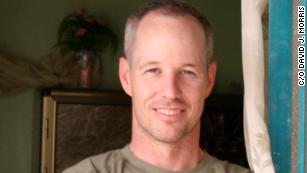Mackinnon was sitting huddled in the corner of a cafe with her two children, sipping hot chocolate as she described the day three years ago when she was walking with her Border collie, Bonnie, over the Overtoun Bridge in Dumbarton, Scotland.
“Something overcame Bonnie as soon as we approached the bridge,” Mackinnon said. “At first she froze, but then she became possessed by a strange energy and ran and jumped right off the parapet.”
A bewitched dog lured to leap off a bridge by a malevolent force? It sounds like a preposterous scene straight from an old “Twilight Zone” episode.
But Mackinnon’s dog is one of hundreds that Scots insist have suddenly been compelled to throw themselves off the gothic stone structure since the 1950s. Many have ended up dead on the jagged rocks in the deep valley bed below.
Mackinnon, who grew up in the neighbouring village of Milton, winced at the memory of scurrying down the gorge through the trees and the bushes in a desperate hunt for Bonnie. But when she approached the dog’s body, Bonnie started to whimper and eventually tried to stand up.

In a land rife with superstitions, myths and monsters — Scotland is the land of the Loch Ness legend, after all — the bridge has been at the centre of an enduring mystery. Why do so many dogs jump?
Local researchers estimate more than 300 have sailed off the bridge; tabloid reports say it’s 600. At least 50 dogs are said to have died.
Some say there are rational explanations involving the terrain and the scents of mammals in the gorge that may drive the dogs into a frenzy.
Other explanations take on a more paranormal tone.
The bridge’s location, hushed, lush and sometimes still, fits the description of what the pagan Celts called a “thin place,” a mesmerizing spot where heaven and earth overlap.
“People in Dumbarton are very superstitious,” said Alastair Dutton, a local taxi driver. “We grew up playing in the Overtoun grounds, and we believe in ghosts here because we’ve all seen or felt spirits up here.”
The leaps inspired an episode of the American TV series “The Unexplained Files.” An entire book is dedicated to exploring the phenomenon.
But despite all this attention, the mystery lives on, unsolved.
From a distance, its seems as if the ornate Victorian bridge, built in 1895, is a mere extension of the driveway of an adjoining 19th-century manor built in Dumbarton by a wealthy industrialist, James White.

In the manor nearby, the current tenant, Bob Hill, said he and his wife had seen several dogs suddenly dive off the bridge since they moved into the property, now called Overtoun House, more than 17 years ago.
But Hill, a pastor from Texas who runs a local center for women in crisis, had an earthbound explanation: The smell of small animals scurrying around in the gorge below the bridge drives the dogs into a frenzy, then they break free of leashes — if they’re on any — and jump.
“The dogs catch the scent of mink, pine martens or some other mammal, and then they will jump up on the wall of the bridge,” Hill said. “And because it’s tapered, they will just topple over.”
Still, he allowed, the Overtoun grounds are “more spiritual than other parts.”
“Scotland is kind of a place where there is a lot of the supernatural, and it is very common in people’s lives,” he added.
Paul Owens, a teacher of religion and philosophy in Glasgow, grew up in a town close to the bridge and recently published a book about the mystery. When it comes to an explanation for the leaping dogs, he is firmly in the supernatural camp.
“After 11 years of research, I’m convinced it’s a ghost that is behind all of this,” he declared, while sitting outside a pub on a drizzly day in Glasgow.
Owens’ theory is popular among some local residents, who grew up hearing stories about the “White Lady of Overtoun,” also known as the grieving widow of John White, James’ son.
“The lady lived alone in grief for more than 30 years after her husband died in 1908,” said Marion Murray, a Dumbarton resident. “Her ghost has been lurking around here ever since. She’s been sighted in windows and walking around the grounds.”

His experiments at the bridge found that dogs — especially long-nosed breeds — were drawn to the scent of mammals below. Sands theorized that the dogs’ limited perspective, their ignorance that the path changes from level ground to a bridge spanning a deep gorge and the smells wafting through the air probably enticed the dogs to jump.
But even he acknowledged that the bridge has a “strange feeling.”
Some residents found his theory plausible, but many here still take the position that the leaps are inexplicable. They question why the phenomenon does not occur at the same rate at other bridges in Britain where mammals roam below.
“Other bridges don’t have troubled spirits lurking about,” Mackinnon insisted grimly.
Despite the macabre reputation, the Overtoun grounds remain a popular dog-walking area, and many of the animals are off leash.
“Many people don’t believe in the story until they see it for themselves, and even then they don’t think it will happen to them,” said Hill, the pastor.
One day, Emma Dunlop, who said she had heard “the horror stories,” took her Labrador retriever, Ginger, for a walk to Overtoun anyway.
She did not let him out of her station wagon until he was on a leash.
“He’s never tried to jump,” she said, “but sometimes he freezes or hesitates when he gets on the bridge, so I’m always careful.”
Ginger jumped from the car, raced around his owner and headed straight toward Overtoun Bridge, crossing it without any hesitation.
But then Ginger froze, looking back intently at something on the bridge, which appeared empty to human eyes.
“Aye, there she is — there’s the White Lady,” Dunlop said with a laugh, suggesting Ginger had seen the bridge’s ghost.
Then the pair continued their walk.

























